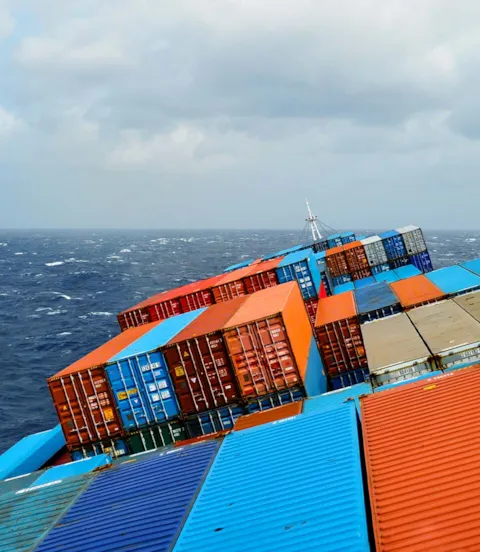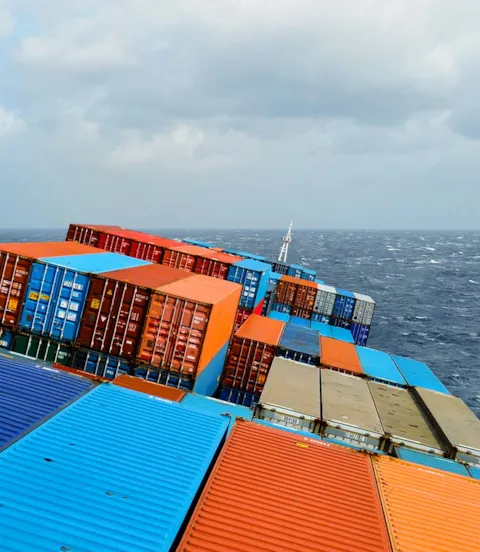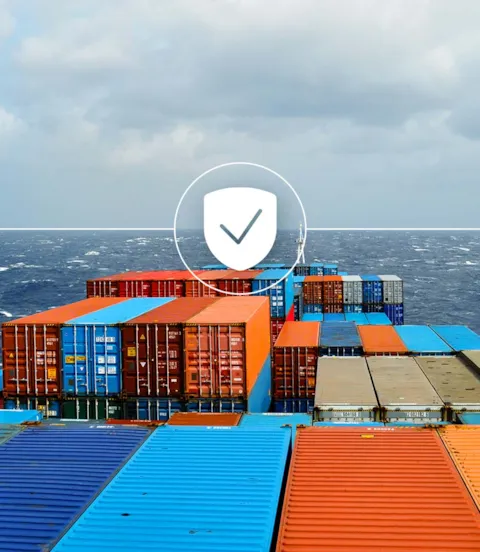New DNV anti-roll app helps avoid container loss
Synchronous or parametric rolling occurs suddenly and is hard to control. DNV’s new Anti-Roll Assist app now allows captains to recognize and avoid the risk before it becomes a threat.
Resonant rolling is a hydrodynamic phenomenon that can leave even the most experienced captains at a loss. The ship suddenly begins to rock sideways excessively, and in the worst case containers go overboard. It may happen so fast that there is practically no time to react. This has prompted DNV, after years of research, to develop an easy-to-use software app that can help shipmasters avoid this situation altogether.

Rare events which make big headlines
Container loss at sea is relatively rare, considering that more than 200 million containers are shipped across the world’s oceans every year, says Arne Schulz-Heimbeck, Senior Principal Engineer and Programme Development Manager for Containerships at DNV. Yet those few incidents make big waves in the media and can damage the reputation of the shipowner and operator, in addition to the financial loss. Furthermore, lost containers floating in the water are a hazard for ocean traffic, especially for smaller ships.

Good maintenance and seamanship protect the cargo
DNV-classed containerships with a certified lashing system are designed to operate in harsh conditions without losing cargo, assuming good maintenance and good seamanship. Unless the ship begins to roll uncontrollably. “There are two types of dangerous roll events: synchronous and parametric rolling,” explains Schulz-Heimbeck. “Both result from highly complex interactions of several factors and are hard to predict. By the time you notice them it is often too late to take remedial action.”

Synchronous rolling
Synchronous rolling happens when the wave direction is approximately perpendicular to the direction of travel, the ship’s natural roll frequency is close to the wave frequency, and the metacentric height, which indicates the ship’s initial static stability, is relatively high. The angle of heel can quickly increase to as much as 30 degrees, says Schulz-Heimbeck. “The effect is aggravated significantly in shallow water, typically in continental shelf regions where the waves are shorter and steeper. This increases the risk of synchronous rolling disproportionally when the wave period is similar to the ship’s roll frequency.”

Parametric rolling
In contrast to synchronous rolling, parametric rolling is induced by waves moving approximately in parallel with the direction of travel, either following or contrary to its heading. A relatively low metacentric height increases the risk of parametric rolling. When the wave frequency approximates the ship’s natural roll frequency, parametric resonance can cause excessive rolling. “As head, following or quarterly waves run along the ship, the waterplane area changes, and with it the righting lever curve whose periodical changes can cause the ship to roll heavily,” explains Schulz-Heimbeck.
In either case, the roll angle can rise steeply and reach dangerous levels within minutes, the expert adds. By the time the shipmaster realizes that an excessive roll event is occurring, there may be just minutes left to take action. Without fully understanding what is going on, shipmasters may simply not know what to do in such a situation, or even act in the wrong way, for example by reducing the ship speed instead of increasing it, which can be remedial in particular situations.

A new approach to understanding resonant rolling
DNV has accumulated substantial expertise in the field of parametric and synchronous rolling over decades and developed direct stability assessment and ship-specific operational guidance based on non-linear numerical simulations of ship motion in waves. DNV’s hydrodynamic computation method for seakeeping and two complementary simulation methods validated over 15 years provide a solid basis for predicting resonant roll events.
DNV provides specific operational guidance to crews to help them avoid risks by presenting them with an easy-to-understand overview of the current situation from which they can draw immediate conclusions for navigation.

An app providing clear visualized information
The DNV strategy expressly avoids long-winded literature, ship design modifications, cargo or operational restrictions, or additional requirements for the lashing system. It aims to deliver accurate, reliable and up-to-the-minute visualized guidance through an app which can be used on board as well as at the operational centre on shore. “Our new Anti-Roll Assist app draws a clear picture of the risk situation so a captain knows immediately what can be done to avoid losing containers due to excessive rolling,” says Schulz-Heimbeck.
The app relies on DNV’s hydrodynamic simulations based on the individual ship’s hull form. “This is important because the actual hull contours and the way the waterlines change are key factors determining the roll amplification effect,” Schulz-Heimbeck continues. “We use a 3D simulation model of the hull, combined with a number of realistic loading cases provided by the customer. Then we simulate the behaviour of the vessel in a variety of sea states and loading conditions.”

Simulations require enormous computing power – the app does not
These simulations are run in advance. Because of the complexities involved, they require the power of a supercomputer, which still takes three to five weeks per simulation. The calculation results are then stored in a seakeeping response database on the ship’s computer – where 500 MB of storage space is sufficient. “This database allows the app to perform specific situational calculations very efficiently and quickly to analyse any given situation,” says Schulz-Heimbeck. “The app uses a handful of input parameters: the current draught, trim, metacentric height, heading, speed and water depth as well as online wave data plus the factor for route-specific container stowage (RSCS+) from the lashing computer. It outputs a prediction of the lashing system utilization for the given loading condition.”

Polar diagram delivers clear, simple information
The app presents its output in the form of a polar diagram which represents the heading and speed of the ship and the strain on the lashing system on a colour scale from deep blue for “zero load” to deep red for “maximum load exceeded”.
“By looking at the diagram, the captain can see whether the ship is operating in or near a risky situation, and conclude whether changing the speed or course is the best option to avoid a roll risk,” explains Schulz-Heimbeck. “What is especially important is the fact that the app allows the crew to assess the situation well ahead of time, and verify the situation repeatedly as the ship approaches a critical section of the voyage. It provides immediate, well-founded, practical decision support.” First containership owners are testing the new app and are convinced of its features and convenient handling. Captain Ortwin Muehr, Head of nautical department at CPO Containerschiffreederei confirms: “We are piloting the new Anti-Roll Assist App by DNV on a series of container ships and our captains are appreciating the straight-forward and easy to use app. The tool provides an accuracy level that allows the planning of a fuel-efficient route avoiding critical situations.”

Integration in routing systems in progress
While the Anti-Roll Assist app is currently used as a stand-alone product, DNV has created application programming interfaces (APIs) for integration in bridge software systems. “We are working with StormGeo, who have already implemented our API in their new voyage planning and routing software. Going forward we are also open to integrate our API in the routing and navigation software products of other bridge software providers interested in improving the safety standards for their customers,” says Holger Jefferies, Head of DNV’s Containership Excellence Centre. “This means that the API can pull the latest weather and sea state data from the navigation system automatically. The polar diagram showing the load on the lashing system will appear on the display of the navigation system. This makes risk avoidance decisions even easier.”

Reporting feature justifies navigational decisions
The app allows the captain a look into the future to anticipate critical situations well in advance and make appropriate operational adjustments. Not only that, but its integrated reporting feature documents the reasons for these decisions so the crew can later defend deviations from the predetermined route.
For vessels without an integrated routing or navigation system, DNV is developing a web-based, stand-alone, anti-roll alert tool which uses the same logic as the Anti-Roll Assist app and will be available on the DNV Veracity platform. After inputting key static data at the beginning of a voyage, the tool will use AIS, geolocation, water depth and weather data, as well as the ship’s speed and heading to compute a risk assessment and issue a warning if there is a risk for the lashing system. The tool will send warnings by email or any text messaging app to both the operations centre and the crew on board.

New class notation Anti-Roll for Containerships
DNV’s anti-roll software and services are supported by a new class notation called ARCS (Anti-Roll for Containerships) which enables shipowners to demonstrate to their customers that a strategy to minimize the risk of container loss is in place. Owners have two options to meet the requirements of the ARCS class notation: implement a software solution which meets certain functional, technical and performance requirements, particularly a stringent hydrodynamic approach to calculating the risk, or install anti-rolling tanks. DNV expressly encourages design efforts in this field.
“This innovative anti-roll strategy is only possible because of technological achievements made in recent years, including highly accurate satellite-based weather and sea state data like that offered by the Copernicus programme,” says Holger Jefferies. “Combined with our hydrodynamic simulations on powerful computers, we are now able to address a rare but serious issue effectively.”

Arne Schulz-Heimbeck
Senior Principal Engineer and Programme Development Manager for Containerships
- Shutterstock / Alexey Lesik
- Shutterstock / Evgeny Shulin
- Shutterstock / Alexey Lesik
- DNV